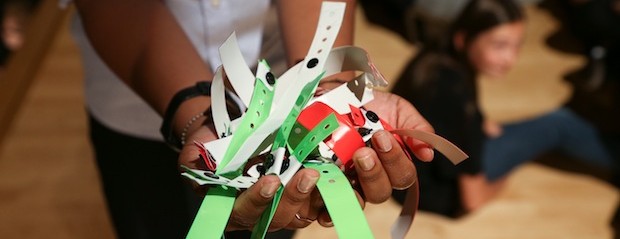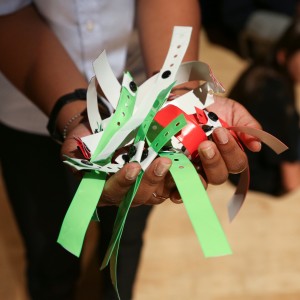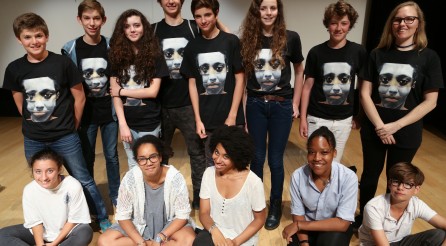Atticus Finch said, You never really understand a person until you consider things from his point of view; until you climb into his skin and walk around in it. On Monday, June 8, eighth-grade students at the LFNY attempted to do just that.
The focus of the LFNY class delegates this year was diversity. Each grade was assigned one of the eight diversity identifiers (Race, Gender, Sexual Orientation, Age, Religion, Ethnicity, Socioeconomic Status, and Physical/Mental Ability). The eighth graders were assigned the theme of race. During their planning and collaboration meetings at the beginning of the school year, the student delegates began to develop a project reminiscent of Jane Elliott’s Blue Eye/Brown Eye Experiment (see video of the experience below).
Elliott began her experiment in 1968 in response to the assassination of Martin Luther King Jr. “I was going to have to go into my classroom and explain to the students why the adults in this country had allowed somebody to kill hope; because Martin Luther King, for me, was hope for this country” she said. Elliott taught third grade at a small, all-white school in Iowa and sought a way to help her students truly understand discrimination. She divided them based on eye color and told the group that blue eyed children were better than brown eyed children, “This is a fact,” she said.
The red and green bracelets 8th graders wore on Monday.
During their Journée Contre le Racisme, the eighth-grade students were not divided by eye color, but instead, were given at random either a red or green bracelet to wear throughout the day. Red bracelets were given systematic disadvantages, while green bracelets were given systematic privileges. Some of these divisions were designed to be reminiscent of those imposed during segregation; certain drinking fountains were labeled “Greens Only”, red bracelets were made to sit on the floor in the back of the classroom while green bracelets sat up front in chairs, red bracelets were asked to present multiple forms of identification in order to enter or leave the building. Others were designed to help students understand the impact of prolonged behavioral generalizations; each time a green bracelet would do something well, teachers would say things to the effect of, “see how smart green bracelets are?” Each time a red bracelet would do something wrong, the same types of generalizations were made, “red bracelets are always late, perhaps they aren’t smart enough to tell time.”
Feeling and acting superior
The students quickly began to feel the effects and their behavior began to change. Some red bracelets tried to rebel against the restrictions imposed upon them, others attempted to hide their bracelets under long sleeves in order to go unnoticed. Students with green bracelets began to feel and act superior to those with red bracelets, many even began to give red bracelets orders. However, there was not exclusively abuse of power on among the green bracelets; on rare occasions, green bracelets placed themselves side-by-side with the reds, in an attempt to protect them from their oppression.
8th grade class delegates as well as students from the Diversity Committee were responsible for organizing the Journée Contre le Racisme.
The day concluded with an assembly in the auditorium where students watched a video of Jane Elliott’s experiment before dividing into advisory groups for discussion. The conversations were facilitated either by class delegates, or members of the Student Diversity Committee. The students shared their thoughts and feelings about the day, as well as feedback for ways the experience could be improved in the future.
Highlight the systemic privileges and disadvantages
Leading up to the experience, the delegates designed and sold t-shirts which they were allowed to wear on Monday. The proceeds from the sale of the shirts, $210, were donated to Erase Racism NY, an organization based in Long Island which works to eliminate racial disparities, particularly in the areas of housing, community development, public education and health.
While our students did not stretch the experience to the extent Elliott did, the mission remained the same: to highlight the systemic privileges and disadvantages people experience throughout their daily lives based on factors entirely beyond their control. While the students focused their project on race, they also recognized that discrimination occurs across all identifiers of diversity and the intersections in between. This day gave 8th grade students the opportunity to recognize the effects of either having power or feeling completely powerless. The hope is that students left school on Monday with a better understanding of what it is to walk in the shoes of another.
About the Author :
Lauren Neidhardt received her degree in Public Policy and Sociology from Hobart and William Smith Colleges in 2006 and her Masters in Social Work from The Ohio State University in 2012. Between undergraduate and graduate school she served as a Peace Corps volunteer in Togo, West Africa. Lauren currently works as the 8th Grade Student Life Coordinator at the LFNY as well as being the Student Diversity Coordinator for the Secondary. Lauren is passionate about diversity and inclusion within schools and works to raise awareness and generate conversation about these important issues among students.



